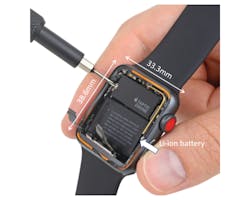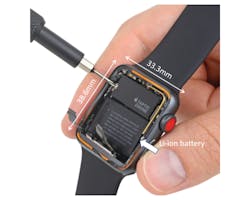How to Extend Battery Run-Time for Wearable Applications (.PDF Download)
“Doing more with less” isn’t just a line from your CEO’s latest speech about corporate cost-cutting—it’s practically a mantra for designers of wearable electronic devices. Every new generation of smartphone, fitness band, and smartwatch offers an ever-increasing array of features. The Apple Watch Series 3 (Fig. 1), for example, includes an accelerometer, gyroscope, heart-rate sensor, microphone, speaker, barometric altimeter, ambient light sensor, Wi-Fi, Bluetooth, NFC, GPS, and optional LTE phone. Oh, and it tells the time, too.
1. Like most wearables, the Apple Watch Series 3 leaves little room for its 279-mAh battery. Nonetheless, the watch can run for up to 18 hours with occasional use. Just be careful about talking on the phone—that can reduce the run-time to as little as one hour. (Source: ifixit.com)
This increased functionality results in greater power usage. Add in the continuing trend toward smaller, thinner packages, and something’s gotta give.
In this case, it’s often the space allotted for the battery. No longer do current-generation smartphones allow the user to swap out the battery when its performance starts to degrade; the user-replaceable battery has become a victim of the drive toward ever-thinner devices.
There’s even less space available for a battery in a wearable. A smartwatch or fitness band often only has room for a single-cell Li-Ion battery with a voltage of 3.8 V and a capacity of 130 to 410 mAh.
Not surprisingly, a smaller battery has a smaller capacity—less energy for those power-hungry new features. As a result, one of the most common complaints from buyers of wearables is short battery life.

